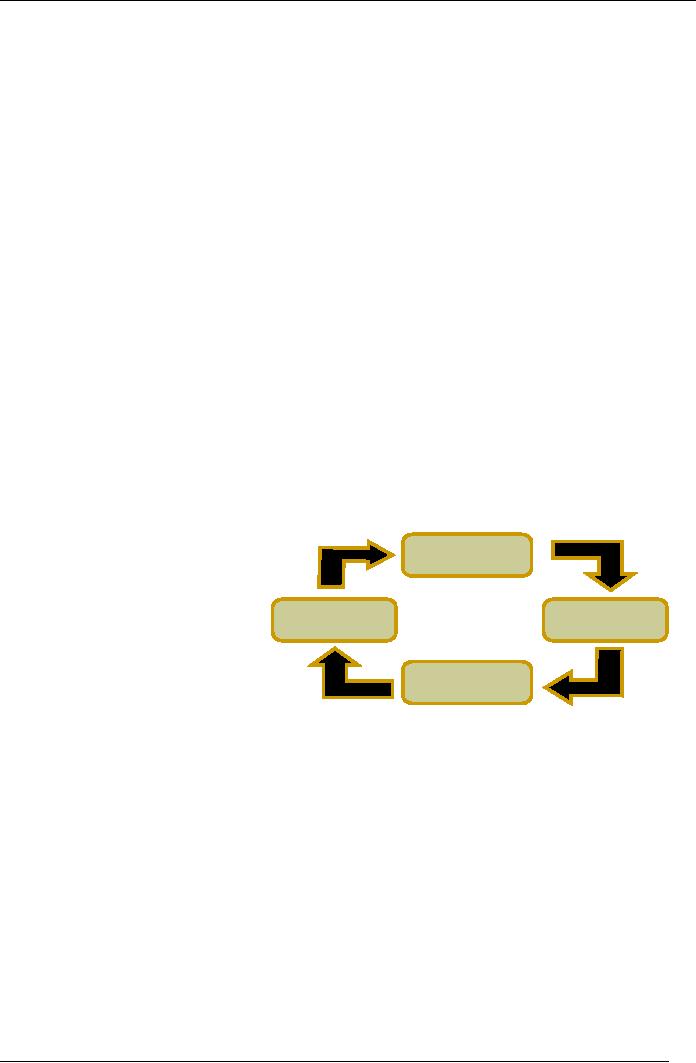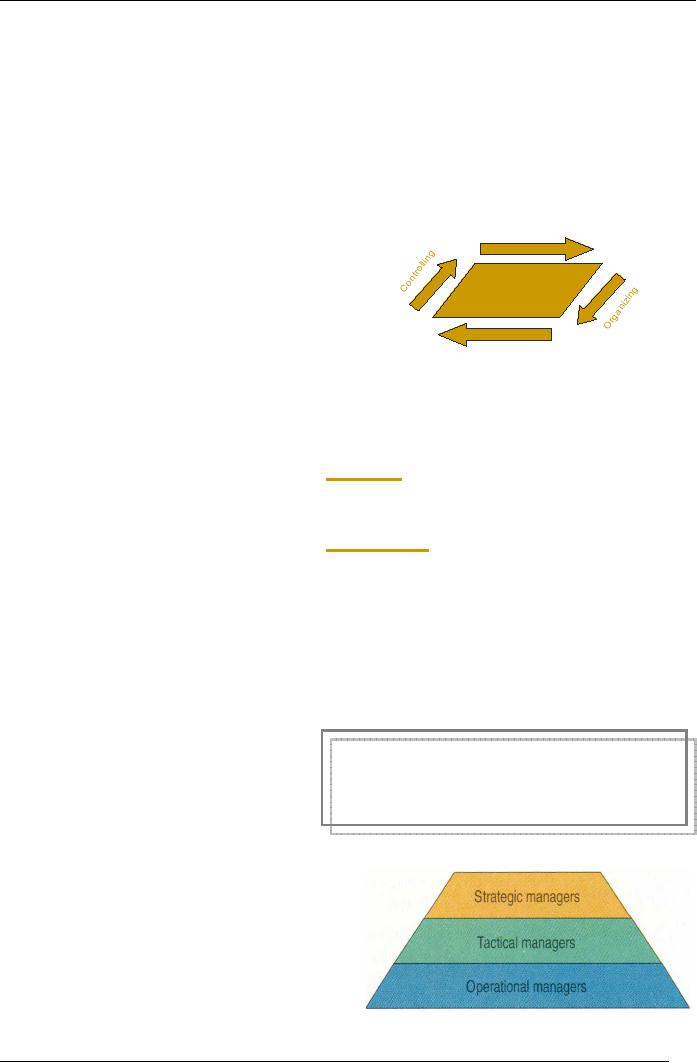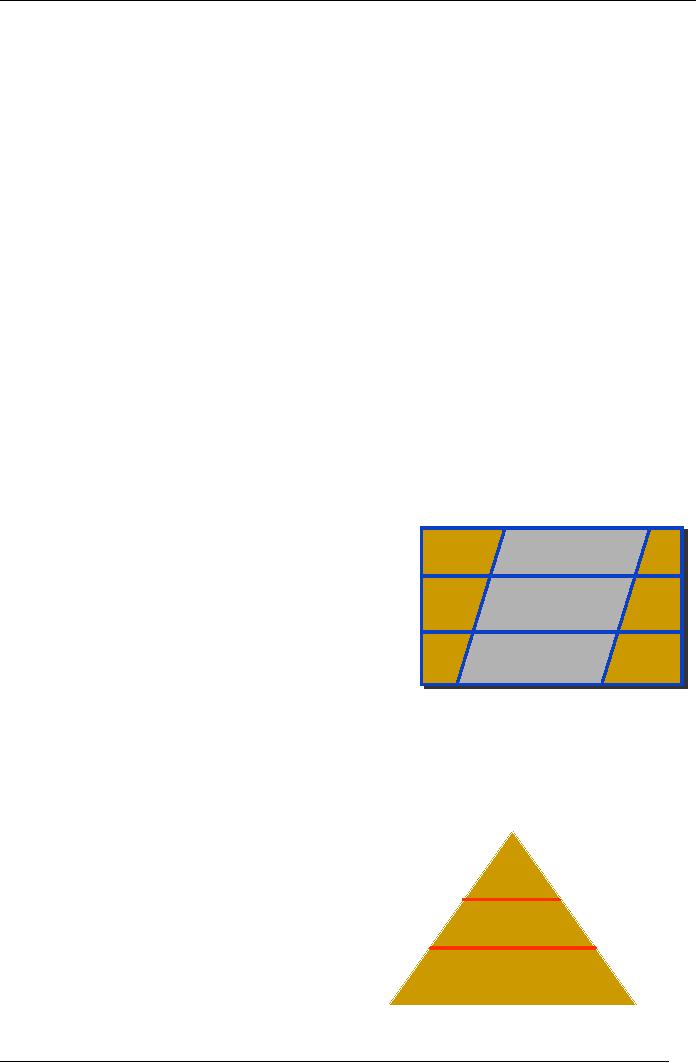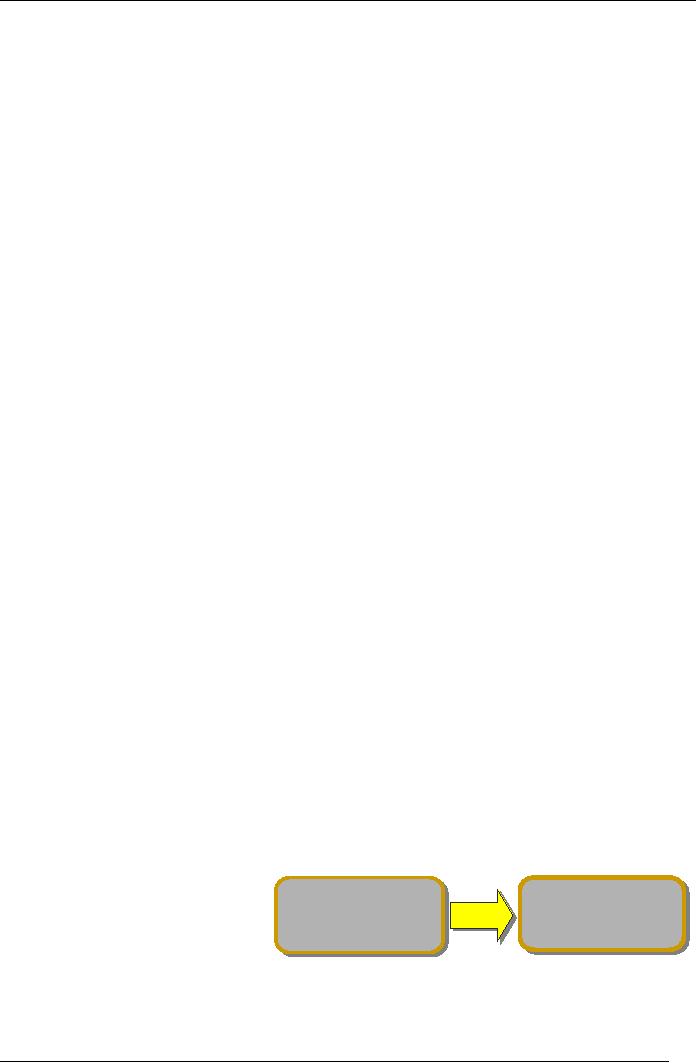 |

Human
Resource Management
(MGT501)
VU
Lesson
2
ESSENTIALS
OF MANAGEMENT
LESSON
OUTLINE
After
studying this chapter, students should be
able to understand the
following:
Concepts
and Essential of Management
Management
and its relationship with
HRM
LESSON
OVERVIEW
This
lecture discusses the management
process and its role in the
organization. To start with, first of
all we
will
define the Management and then we
will go through the functions of
management as well as
relationship
between management and
HRM
.
A.
Concepts and Essential of
Management
i.
What is Management?
Management
is the process of working with
different resources to accomplish
organizational goals. Good
managers
do those things both effectively
and efficiently. To be effective
is to
achieve organizational goals. To
be
efficient
is to
achieve goals with minimum
waste of resources, that is,
to make the best possible
use of
money,
time, materials, and people. Some
managers fail on both criteria, or
focus on one at the expense
of
another.
The best managers maintain a
clear focus on both
effectiveness and
efficiency.
ii.
The Functions of Management
What
can managers do to be effective and
efficient? The management process,
properly executed, involves
a
wide variety of activities including planning,
organizing, leading, and
controlling.
These
activities, described below,
are
Functions
of Management
the
traditional
functions
of
management
Planning
a.
Planning
Planning
is
specifying the goals to be
achieved
and deciding in advance the
Controlling
Organizing
appropriate
actions taken to
achieve
those
goals. Planning activities include
analyzing
current
situations,
Leading
anticipating
the future, determining
objectives,
deciding what types of
Dr.
Mukhtar Ahmed
activities
the company will engage
in,
choosing
corporate and business strategies,
and determining the resources needed to
achieve the
organization's
goals. The outcome of the
planning process is the organization's
strategy.
b.
Organizing
Organizing
is
assembling and coordinating the
human, financial, physical,
informational, and
other
resources
needed to achieve goals.
Activities include attracting people to the organization,
specifying job
responsibilities,
grouping jobs into work units,
marshalling and allocating resources,
and creating
conditions
so
that people and things work together to
achieve maximum success. The
outcome of organizing is an
organizational
structure.
c.
Leading
Leading
is stimulating
people to be high performers. It is directing,
motivating, and communicating
with
employees,
individually and in groups. Leading
involves close day-to-day contact
with people, helping to
guide
and inspire them toward achieving
team and organizational goals. Leading
takes place in teams,
departments,
divisions, and at the tops of entire organization.
The outcome of leading is a
high level of
motivation
and commitment.
7

Human
Resource Management
(MGT501)
VU
d.
Controlling
Comprehensive
plans; solid organization, and outstanding
leaders do not guarantee
success. The fourth
functional
controlling, monitors progress
and implements necessary
changes. When managers
implement
their
plans, they often find that
things are not working out
as planned. The controlling
function
makes sure
that
goals are met. It asks
and answers the question,
"Are our actual outcomes
consistent with our goals?"
It
makes
adjustments as needed. Specific
controlling activities are to set
performance standards that
indicate
progress
toward long-term goals; to
identify performance problems by
comparing performance data
against
standards;
and to take actions to
correct
problems.
Budgeting, information systems,
cost
The
Management Process
cutting,
and disciplinary action are just a few
of
the
tools of control. Successful
organizations,
large
and small, pay close
attention to how well
HUMAN
PHYSICAL
Planning
RESOURCES
RESOURCES
they
are doing. They take fast
action when
problems
arise, and are able to
change as needed.
The
outcome of controlling is an
accurate
ORGANIZATIONAL
GOALS
measurement
of performance and
regulation
of
efficiency and
effectiveness
iii.
Effectiveness & Efficiency
Leading
INFORMATION
FINANCIAL
RESOURCES
RESOURCES
Productivity
= Efficiency x Effectiveness
Dr.
Mukhtar Ahmed
a.
Efficiency
is the
ratio of
Organizational
Performance
outputs
to inputs.
b.
Effectiveness
is the
degree
Efficiency:
A
measure of how well
resources
to
which the organizations
are
used to achieve a goal
output
correspond to the
"Doing
Things Right"
need
and wants of
the
external
environment that
Effectiveness:
A
measure of the
include
customers' suppliers'
appropriateness
of the goals chosen (are
these
the
right goals?), and the
degree to which they
competitors
and regulatory
are
achieved
agencies.
"Doing
the Right Things Right"
iv.
Manager
Dr.
Mukhtar Ahmed
The
member of the organization who
participates
in the management process by planning,
organizing, leading, or controlling the
organization's
resources.
v.
Types of Mangers
There
are three types of
mangers...
`Managing
is like holding a dove in your hand.
If
you squeeze too tight, you kill it. Open your
1.
Strategic
Manager:
Strategic
managers
are the senior
executives
hand
too much, you let it go' -
T. Lasorda
of
an organization and
are
responsible
for
its
overall
management.
Major activities include developing the company's
goals and plans.
Typically
strategic
managers focus on
long-term
issues
and emphasize the survival,
growth,
and
overall
effectiveness
of
the
organization.
2.
Tactical
Managers: Tactical
managers are
responsible
for translating the general
goals
and
plans developed by strategic
managers
into
objectives that are more
specific and activities.
These decisions, or tactics,
involve
both a
8

Human
Resource Management
(MGT501)
VU
shorter
time horizon and the coordination of
resources. Tactical managers are
often called middle
managers,
because in large organizations they
are located between the
strategic and operational
managers.
Today's best middle managers
have been called "working
leaders." They focus on
rela-
tionships
with other people and
on
achieving results. They are
hands-on, working managers.
They
do
not just make decisions,
give orders, wait for others to
produce, and then evaluate
results.
They
get dirty, do hard work
themselves, solve problems,
and produce value.
3.
Operational
Managers: Operational
managers are lower-level managers
who supervise the
operations
of the organization. These managers often
have titles such as supervisor or
sales
manager.
They are directly involved
with non-management employees,
implementing the specific
plans
developed with tactical managers.
This role is critical in the organization,
because opera-
tional
managers are the link
between management and
non-management personnel. Your
first
management
position probably will fit
into this category.
vi.
Managers are
Universal:
Managers
work in all types of
organizations, at all levels,
and in all functional areas.
Large and small
businesses,
hospitals, schools and
governments benefit from
efficient and effective management.
The
leaders
of these organizations may be
called executives, administrators, or
principals, but they are
all
managers
and are responsible for the
success or failure of the organization. This
success or failure is
reflected
in a manager's career. For
example, when a CEO saves a
failing corporation, the board
rewards
this
success with bonuses and
stock options. When a
professional football team
starts losing, the owner
fires
the coach, not the
team.
vii.
The Managerial Skills
Managers
need three basic sets of
skills: technical, interpersonal, and
conceptual.
a.
Technical Skills
Managerial
Skills & Managerial
Level
The
skills that include knowledge of
and
proficiency
in a certain specialized field
Managers
Top
Managers
need
to be technically competent. They need
to
know
how to plan, organize lead
and control. Line
Middle
managers
need this skill the most
while top
Managers
manager
will need minimum of
technical skills.
Line
b.
Interpersonal Skills/Human
Skills
Interpersonal
skills include the ability to work
well Managers
with
other people both individually
and in a
Conceptual
Human
Technical
group.
Mangers need good interpersonal
skills,
knowledge
about human behaviors and
group
processes,
ability to understand the feelings,
attitudes and motives of
others, and ability to
communicate,
clearly
and persuasively. Human
skills are very
important
at each level of management.
Levels
of Managers
c.
Conceptual Skills
Conceptual
skills include the ability to think
and to
conceptualize
about abstract and complex
situations,
to
see the organization as a whole, and
to
Top
Managers
understand
the relationships among the
various
subunits,
and to visualize how the organization
fits
Middle
into
its broader environment. Conceptual
skills
Managers
include
analytical ability, logical thinking,
concept
formation,
and inductive reasoning.
They manifest
First-line
themselves
in things like good judgment,
creativity,
Managers
and
the ability to see the big picture.
Top
mangers/CEO
needs this type of skill the
most.
Dr.
Mukhtar Ahmed
9

Human
Resource Management
(MGT501)
VU
viii.
Levels
of Management Three level in the
organization can classify managers,
particularly for
traditionally
structured organizations...
1.
First-line
managers are
the lowest level of management. They're
often called
supervisors
2.
Middle
managers include
all levels of management
between the first-line level and the
top level of
the
organization.
3.
Top managers include
managers at or near the top of the
organization who are responsible
for
making
organization wide decisions and
establishing the plans and
goals that affect the entire
organization.
Manager's
Roles:
a.
Interpersonal roles
�
Figurehead--duties
that are ceremonial and
symbolic in nature
�
Leadership--hire,
train, motivate, and discipline
employees
�
Liaison--contact
outsiders who provide the
manager with information.
These may be individuals
or
groups
inside or outside the
organization.
b.
Informational
roles
�
Monitor--collect
information from organizations
and institutions outside
their own
�
Disseminator--a
conduit to transmit information to organizational
members
�
Spokesperson--represent
the organization to outsiders
c.
Decisional roles
�
Entrepreneur--managers
initiate and oversee new
projects that will improve
their organization's
performance
�
Disturbance
handlers--take corrective action in response to
unforeseen problems
�
Resource
allocators--responsible for allocating human,
physical, and monetary
resources
�
Negotiator
role--discuss issues and bargain
with other units to gain
advantages for their own
unit
All
managers are mostly
concerned with following
activities:
�
Staffing
�
Retention
�
Development
�
Adjustment
�
Managing
change
HR
Professionals'
Responsibilities:
Line
manager
Authorized
to direct the work of subordinates--they're
always someone's boss. In
addition, line
managers
are
in charge of accomplishing the organization's
basic goals.
Staff
manager
Authorized
to assist and advise
line
managers
in accomplishing these
basic
goals.
HR managers are generally
staff
managers.
B.
Management
and
its
Effective
Effective
Effective
Effective
relationship
with HRM
Organiizatiion
HRM
Organ
zat on
HRM
There
are five basic functions
that all
managers
perform:
planning,
organizing,
staffing, leading,
and
controlling.
HR management involves
the
policies and practices
needed to
carry
out the staffing (or
people)
Dr.
Mukhtar Ahmed
10

Human
Resource Management
(MGT501)
VU
function
of management.
HRM
can
help to manage the following
factors in the organization.
�
Productivity
�
Operations
�
Relationships
�
Conflict
�
Stress
�
Reward
systems
Effectiveness
and success of entire organization
depends upon effective manpower of
organization.
Key
Terms
Controlling:
Specific activities are to set
performance standards that indicate
progress toward
long-term
goals
Decisional
roles included
those of entrepreneur, disturbance handler,
resource allocator, and
negotiator
activities.
Disseminator
is a
conduit to transmit information to organizational
members
Disturbance
handlers take
corrective action in response to unforeseen
problems
Effectiveness: A
measure of the appropriateness of the
goals chosen (are these the
right goals?), and
the
degree
to which they are
achieved
Efficiency
measure
of how well resources are
used to achieve a
goal
Entrepreneur:
managers initiate and
oversee new projects that
will improve their
organization's
performance
Figurehead:
duties that are ceremonial
and symbolic in
nature
Informational
roles included
monitoring, disseminating, and
spokesperson activities
Interpersonal
roles included
figurehead, leadership, and liaison
activities
Leadership:
hires, train, motivate, and discipline
employees
Leading: Leading is
stimulating people to be high performers It is directing,
motivating, and com-
municating
with employees, individually
and in groups.
Liaison:
contact outsiders who
provide the manager with
information. These may be
individuals or groups
inside
or outside the organization.
Line
manager:
Authorized to direct the work of
subordinates--they're always someone's
boss. In
addition,
line managers are in charge
of accomplishing the organization's basic
goals.
Management:
Management is the process of working
with different resources to
accomplish organizational
goals.
Manager: The
member of the organization who
participates in the management process by
planning,
organizing,
leading, or controlling the
organization's resources
Monitor: collect
information from organizations
and institutions outside
their own
Negotiator
role: discuss
issues and bargain with
other units to gain advantages
for their own
unit
Organizing
is
assembling and coordinating the
human, financial, physical,
informational, and
other
resources
needed to achieve
goals.
Planning: Planning is
specifying the goals to be achieved
and deciding in advances the appropriate
actions
taken
to achieve those
goals.
Resource
allocators:
responsible for allocating human,
physical, and monetary
resources
Spokesperson:
represent the organization to
outsiders
Staff
manager:
Authorized to assist and
advise line managers in
accomplishing these basic
goals.
11
Table of Contents:
- INTRODUCTION TO HRM:Growing Importance of HRM, Road Map of the Course
- ESSENTIALS OF MANAGEMENT:Concepts and Essential of Management, Manager’s Roles
- ORGANIZATION AND COMPONENTS OF ORGANIZATION:Open versus Closed Systems, The Hawthorne Studies
- PEOPLE AND THEIR BEHAVIOR:Why to work in organizations?, The Goals of Organizational Behavior
- INDIVIDUAL VS. GROUP BEHAVIOR:What Are Roles?, Problem solving Team
- PERSONNEL MANAGEMENT TO HUMAN RESOURCE MANAGEMENT:Records and Administration, Competitive Advantage
- HRM IN A CHANGING ENVIRONMENT:Productivity, New Trends at Work Place
- How organization Cultivate a Diverse Workforce, STEPS TOWARD MANAGEMENT OF DIVERSITY
- FUNCTIONS AND ENVIRONMENT OF HRM:Compensation and Benefits, Safety And Health, Interrelationships of HRM Functions
- LINE AND STAFF ASPECTS OF HRM:Authority, Line versus Staff Authority, Staff Manager
- LEGAL CONTEXT OF HR DECISIONS:Doing the Right Thing, Affirmative Action, Unintended Consequences
- HUMAN RESOURCE PLANNING (HRP):Benefits of HR Planning, Forecasting Human Resource Availability
- STRATEGIC PLANNING AND HRIS:HR’s Strategic Role, Human Resource Information System, Common HRIS Functions
- JOB ANALYSIS:Purposes of the job Analysis, Questions Job Analysis Should Answer
- JOB ANALYSIS:Methods of Collecting Job Analysis Information, Observation, Source of Data
- JOB ANALYSIS (CONTD.):SURPLUS OF EMPLOYEES FORECASTED, Diversity through Recruiting Efforts
- SOURCES OF RECRUITMENT:ALTERNATIVES TO RECRUITMENT, Quantity of the Applicants, Quality of the Applicants
- SELECTION:Initial Screening, Advantages of Successful Screening
- SELECTION TESTS:Characteristics of Properly Designed Selection Tests, Guidelines for Conducting an Interview
- SELECTION PROCESS… CONTD:Background Investigations, Physical Exam, Selecting Managers
- SOCIALIZATION:Compensation and Benefits, Team Membership, Stages in socialization Process, Training and Development Trends
- TRAINING AND DEVELOPMENT:Learning, Phases of Training, Why Transfer of Training Fails
- MAXIMIZING LEARNING:Following up on Training, Repetition, Feedback, Purposes of T & D
- CAREER MANAGEMENT:Individual career planning, Career Planning and Development Methods
- PERFORMANCE:Determinants of Job Performance, Why is performance measured?, Performance Management
- PERFORMANCE APPRAISAL:What to Evaluate, The Appraisal Interview, PROBLEMS IN PERFORMANCE APPRAISAL
- JOB EVALUATION AND PRICING:THE APPRAISAL PERIOD, Ranking method,
- COMPENSATION SYSTEM:Pay, Job Pricing, Compensation: An Overview, Compensation Surveys
- BENEFITS:Total Compensation, Discretionary Benefits (Voluntary), Workplace Flexibility
- ROLE OF MONEY IN PERFORMANCE OF EMPLOYEES:Types of Pay-for-Performance Plans, Empower Employees
- MOTIVATION:The Motivation Process, Motivational Theories, Challenges of motivating employees
- OCCUPATION, HEALTH & SAFETY:Physical Conditions, Accident Investigation, Smoking in The work place
- STRESS MANAGEMENT:Symptoms of Stress, Managing Stress,
- COMMUNICATION IN ORGANIZATION:Burnout, Social Support at Work & Home, Communication in organization, Meetings
- TRADE UNIONS:Collective Bargaining, The HRM Department in a Nonunion Setting, Phases of Labor Relations
- CONFLICT AND NEGOTIATION:Transitions in Conflict Thought, Individual Conflict Management Styles
- POWER AND POLITICS:Sources of Power, Advantages and Disadvantages of PowerPower and Politics in Context
- EMPLOYEE RIGHTS AND DISCIPLINE:Contractual Rights, Management Rights, Disciplining Employees,
- DISCIPLINE (CONT...):Factors to Consider when Disciplining, Disciplinary Guidelines, Employee Separations
- LEADERSHIP:The Leader’s Behavior, Situational Theories of Leadership, Becoming a Leader
- REVISION (LESSON 12-21):Plans, Job Specification, Human resource planning, Selection Process, Corporate Culture
- REVISION (LESSON 22-26):Training, Case Study Method, Training, Performance
- REVISION (LESSON 27-35):Classification Method, Compensation, Empowerment, Mediation
- INTERNATIONAL DIMENSIONS OF HRM:Global Corporation, Type of staff members, Approaches to Global Staffing
- CONCLUSION & REVIEW:Strategies for Gaining Competitive Advantage, High-performance Work System